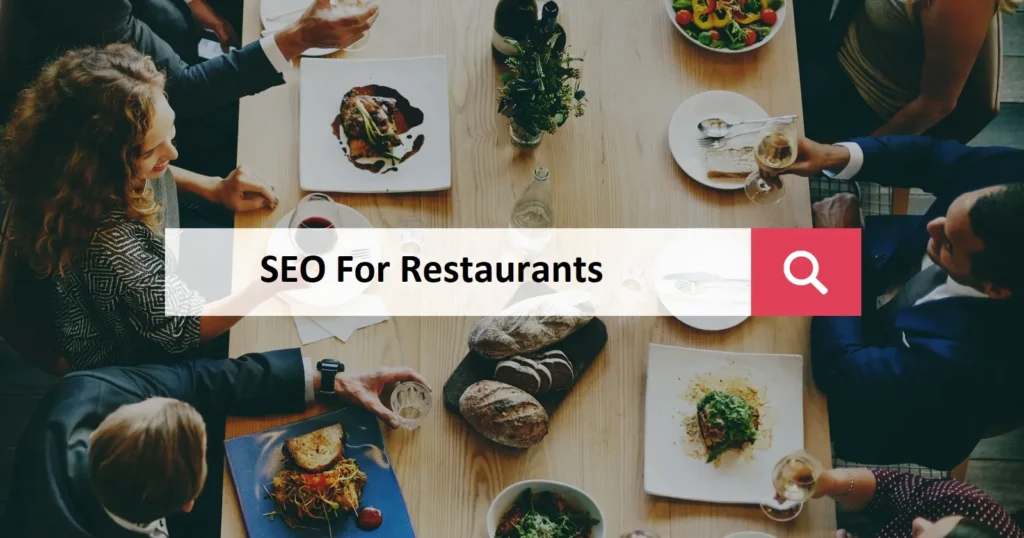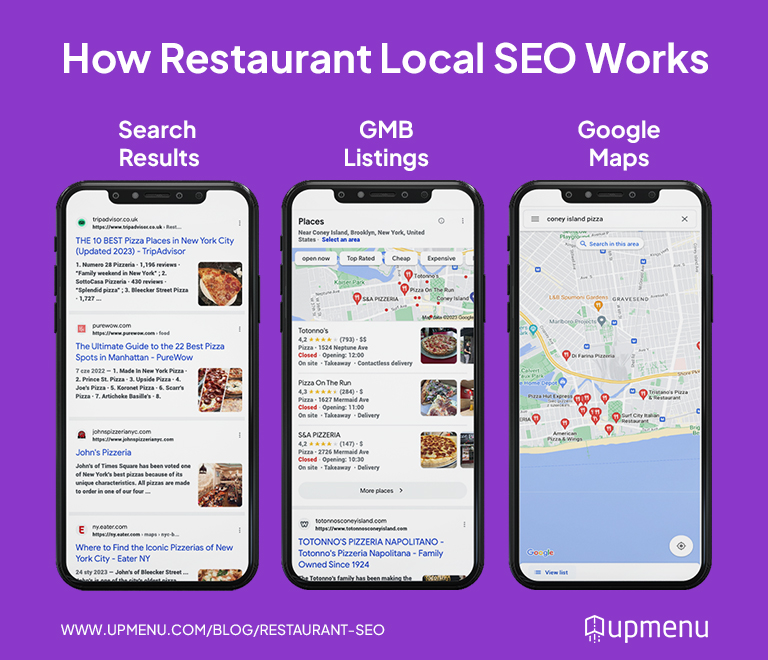
SEO for restaurants involves optimizing your website to rank higher on search engines, driving more traffic and customers. It includes local SEO, quality content, and online reviews.
Effective SEO helps your restaurant appear in local search results, attracting nearby customers. Start by claiming your Google My Business listing to enhance local visibility. Ensure your website is mobile-friendly, loads quickly, and contains relevant keywords. Use high-quality images of your food and venue to entice visitors.
Encourage satisfied customers to leave positive reviews on Google and Yelp. Regularly update your blog with engaging content about your menu, events, and promotions. By implementing these strategies, your restaurant can achieve better online visibility and attract more diners.
Introduction To Seo For Restaurants
Welcome to our guide on SEO for Restaurants. This section covers the basics and benefits. Understanding SEO can help your restaurant thrive online. Let’s dive into why we need SEO for restaurants.
Importance Of Seo
SEO, or Search Engine Optimization, is essential for online visibility. Restaurants need a strong online presence to attract more customers. Here are some key reasons:
- Increases website traffic
- Boosts local search visibility
- Enhances brand credibility
- Improves customer engagement
SEO makes your restaurant easier to find on search engines. It helps you rank higher on Google. This means more potential customers can discover your restaurant. Good SEO practices can turn online searches into actual visits.
Current Trends In Restaurant Seo
Staying updated with current trends is vital. Here are some trends that restaurants SEO should follow:
| Trend | Description |
|---|---|
| Local SEO | Focus on attracting customers in your area. |
| Mobile Optimization | Ensure your website works well on mobile devices. |
| User Reviews | Encourage positive reviews to boost your reputation. |
| Voice Search | Optimize for voice search queries. |
| Social Media | Use social media to connect with customers. |
Keeping up with these trends can give your restaurant a competitive edge. Local SEO helps you appear in local searches. Mobile optimization ensures a good user experience. Positive user reviews build trust. Voice search is growing in popularity. Social media helps you engage with your audience.

Credit: www.searchenginejournal.com
Keyword Research
Keyword research is the backbone of any successful SEO for restaurants. It helps you understand what potential customers are searching for. This ensures your website ranks higher in search engine results. Let’s dive into some essential aspects of keyword research.
Finding Relevant Keywords
Start by identifying keywords relevant to your restaurant. Think about what your customers might search for. Use tools like Google Keyword Planner and SEMrush. These tools help you find popular keywords in your niche.
Create a list of keywords related to your restaurant. Consider your cuisine, location, and specialties. For example, if you own an Italian restaurant in New York, your list might include:
- Italian restaurant in New York
- Best pasta in New York
- Pizza near me
Analyzing competitors can also help. Look at the keywords they rank for. This can give you ideas for your keyword list.
Using Long-tail Keywords
Long-tail keywords are longer, specific phrases. They often have lower search volumes but higher conversion rates. For example, instead of “Italian restaurant,” use “family-friendly Italian restaurant in New York.”
Here are some benefits of using long-tail keywords:
- Less competition: It is easier to rank for these keywords.
- Higher relevance: Attracts more targeted traffic.
- Better conversion rates: Users are closer to making a decision.
Use these keywords in your content, meta descriptions, and headers. This will help your restaurant stand out in search results.
Here’s a quick example:
| Short-Tail Keyword | Long-Tail Keyword |
|---|---|
| Pizza | Best wood-fired pizza in Brooklyn |
| Vegan restaurant | Vegan brunch spots in Manhattan |
Incorporate these keywords naturally in your content. This will make your website more relevant to search engines and users.
On-page Seo
On-page SEO for restaurants aiming to rank higher in search engines. By optimizing your website’s content and structure, you can attract more local customers. This section focuses on key on-page SEO strategies for restaurant websites.
Optimizing Menu Pages
Your menu pages are vital for attracting food lovers. Ensure your menus are easy to read and navigate. Use structured data to highlight dishes, prices, and special offers. This helps search engines understand your menu better.
- Include high-quality images of dishes.
- Use descriptive names for menu items.
- Add customer reviews and ratings.
Consider creating a table for your menu. This makes it easy to scan for users and search engines.
| Dish | Description | Price |
|---|---|---|
| Margherita Pizza | Classic pizza with mozzarella and tomatoes. | $12 |
| Caesar Salad | Fresh romaine lettuce with Caesar dressing. | $8 |
Title Tags And Meta Descriptions
Title tags and meta descriptions are essential for SEO. They help search engines and users understand your page’s content. Make sure each page has a unique title tag and meta description.
- Keep title tags under 60 characters.
- Include primary keywords in title tags.
- Keep meta descriptions under 160 characters.
- Use action words like “Order” or “Book.”
Local Seo Tactics
Local SEO tactics help restaurants attract nearby customers. These strategies ensure SEO for restaurants appears in local search results. Let’s explore some key tactics to boost your local visibility.
Google My Business
Google My Business is essential for local SEO. Set up and verify your listing. Include accurate business details like name, address, phone number, and hours. Use high-quality photos of your restaurant and menu items. Encourage customers to leave reviews. Respond to reviews to show engagement. Update your listing regularly to reflect any changes.
Local Citations
Local citations mention your business on other websites. Ensure NAP (Name, Address, Phone number) consistency across all platforms. Use local directories and review sites. Examples include Yelp, TripAdvisor, and Yellow Pages. These citations improve your local search ranking. They also increase your restaurant’s visibility. Make sure to monitor and update these citations regularly.
| Platform | Action |
|---|---|
| Google My Business | Create and verify the listing, add accurate details, respond to reviews |
| Yelp | Claim your business, add information, monitor reviews |
| TripAdvisor | Claim your business, add photos, respond to reviews |
| Yellow Pages | Ensure accurate NAP, update information as needed |
Both Google My Business and local citations are crucial. They help your restaurant rank higher in search results. They also build trust with potential customers. Implement these tactics to enhance your local SEO strategy.
Mobile Optimization
Mobile optimization is crucial SEO for restaurants. More customers search for eateries on their phones. Ensuring your website is mobile-friendly can boost visibility and bookings.
Responsive Design
A responsive design ensures your website looks great on all devices. This means it adjusts to different screen sizes, including smartphones and tablets.
With responsive design, images resize, and text adjusts for readability. Customers will easily navigate your site, leading to higher engagement.
Use a flexible grid layout. This helps elements align correctly on various devices. Ensure your text is readable and buttons are easy to click.
Mobile-friendly Menus
Menus are crucial for restaurant websites. A mobile-friendly menu enhances user experience and encourages orders.
Use collapsible sections to organize your menu. This keeps the page clean and easy to navigate. Customers can quickly find what they want.
Ensure your menu items are easy to read. Use large fonts and simple descriptions. Include images of dishes to entice customers.
Here is a quick comparison of mobile-friendly features:
| Feature | Benefit |
|---|---|
| Responsive Design | Adapts to different screen sizes |
| Flexible Grid Layout | Aligns elements correctly |
| Collapsible Menu Sections | Keeps the page clean |
| Large Fonts | Easy to read |
Optimizing your restaurant’s mobile site can attract more customers. Focus on making it user-friendly and visually appealing.
Content Marketing
Content marketing is essential for restaurants. It helps attract and retain customers. Creating valuable content builds a loyal audience. This strategy can boost your restaurant’s visibility and reputation.
Blogging For Restaurants
Blogging is a powerful tool for restaurant SEO. It allows you to share stories, recipes, and updates. Regular posts keep your audience engaged and informed.
- Share Recipes: Post detailed recipes of popular dishes. This can attract food enthusiasts.
- Behind the Scenes: Share stories about your staff and kitchen. This creates a personal connection.
- Special Events: Announce upcoming events or promotions. Keep your customers excited.
Regular blog updates improve search engine rankings. Use keywords naturally in your posts. This helps search engines find your content.
Using Social Media
Social media is a vital part of content marketing. It helps reach a larger audience. Platforms like Facebook, Instagram, and Twitter are useful.
- Engaging Posts: Share high-quality photos and videos of your dishes. Visual content grabs attention.
- User Interaction: Respond to comments and messages quickly. This builds a community.
- Promotions: Announce special offers and discounts. This drives more traffic to your restaurant.
Integrate social media with your blog. Share blog posts on your social media platforms. This increases your content’s reach and visibility.
| Platform | Best Use |
|---|---|
| Event announcements, engaging posts, community interaction | |
| High-quality photos, stories, visual content | |
| Quick updates, customer interaction, trending topics |
Link Building Strategies
Effective link-building strategies can elevate your restaurant’s online presence. By connecting with authoritative sites, you enhance your SEO ranking. Here are two key strategies to consider:
Partnerships With Local Bloggers
Building relationships with local bloggers can drive traffic to your website. Bloggers often have a loyal, local readership. Here are some steps to get started:
- Identify Influential Bloggers: Look for bloggers with a strong local following.
- Engage with Their Content: Comment on their posts and share their content.
- Offer Value: Provide unique experiences or exclusive deals for their readers.
These partnerships can result in valuable backlinks to your site. This boosts your restaurant’s visibility.
Guest Posting
Guest posting on food and travel blogs can also boost your SEO. Here’s how you can approach it:
- Research Relevant Blogs: Find blogs that align with your restaurant’s niche.
- Pitch Unique Content: Propose engaging and unique blog topics.
- Include Backlinks: Ensure to include a backlink to your restaurant’s site.
Guest posts help you tap into established audiences. This drives more traffic to your site and enhances your online reputation.
Incorporating these link-building strategies can significantly improve your restaurants SEO.
Review Management
Review management is vital for restaurants in the digital age. It helps build trust and attract new customers. Actively managing reviews can boost your restaurant’s online presence and SEO performance.
Responding To Reviews
Responding to reviews shows you care about your customers. It demonstrates that you value their feedback and are willing to improve. Here are some tips for responding to reviews:
- Thank the reviewer: Always start by thanking the customer for their feedback.
- Address specific comments: Mention specific points the reviewer made.
- Stay professional: Keep your responses polite and professional, even to negative reviews.
- Offer solutions: If the review is negative, offer a solution or invite them back to experience improvements.
Here is an example response to a positive review:
Dear [Customer Name],
Thank you for your kind words and for choosing our restaurant. We are delighted to hear you enjoyed your meal and our service. We look forward to serving you again soon!
Best regards,
[Your Restaurant Name]
Encouraging Customer Feedback
Encouraging customer feedback is crucial for continuous improvement. More reviews can also improve your restaurant’s SEO. Here are some ways to encourage feedback:
- Ask for reviews: Request customers to leave a review after their meal.
- Provide easy access: Place review links on your website and social media.
- Incentivize feedback: Offer small discounts or freebies for leaving a review.
- Engage on social media: Respond to comments and messages to show you value customer input.
Additionally, you can use table cards or receipts with a QR code linking to your review page. This makes it easy for customers to leave a review right from their phone.
| Method | Description |
|---|---|
| Ask for reviews | Verbally request customers to leave a review. |
| Provide easy access | Add review links on your website and social media. |
| Incentivize feedback | Offer discounts or freebies for reviews. |
| Engage on social media | Respond to comments and messages. |
By managing reviews effectively, your restaurant can build a positive online reputation. This will attract more customers and improve your SEO rankings.
Technical Seo
Technical SEO is crucial for restaurants aiming to improve their online presence. It enhances the site’s structure and performance, ensuring a better user experience and higher rankings on search engines.
Site Speed Optimization
Site speed is a critical factor for SEO. Faster sites rank higher on search engines. They also provide a better user experience.
Here are some tips for optimizing site speed:
- Compress images: Use formats like JPEG or PNG. Ensure they are optimized for the web.
- Enable browser caching: Store copies of files locally. This reduces load times.
- Minimize HTTP requests: Combine CSS and JavaScript files. This reduces the number of requests.
- Use a Content Delivery Network (CDN): Distribute content across multiple servers. This speeds up content delivery.
Implement these steps to see a significant improvement in site speed.
Structured Data
Structured data helps search engines understand your site better. Restaurants need to use structured data.
Here is a simple example of structured data for a restaurant:
{
"@context": "https://schema.org",
"@type": "Restaurant",
"name": "Your Restaurant Name",
"address": {
"@type": "PostalAddress",
"streetAddress": "123 Main Street",
"addressLocality": "City",
"addressRegion": "State",
"postalCode": "12345"
},
"telephone": "+1234567890",
"servesCuisine": "Cuisine Type",
"priceRange": "$$",
"openingHours": "Mo-Su 11:00-23:00"
}
Adding structured data can help your restaurant appear in rich snippets. This improves visibility and click-through rates.
By focusing on Technical SEO, restaurants can enhance their online presence. This leads to higher rankings and more customers.
Analyzing Seo Performance
Understanding your SEO performance is crucial for any restaurant. By analyzing data, you can pinpoint strengths and weaknesses. This helps improve your overall SEO strategy. Let’s dive into some key methods to analyze SEO performance effectively.
Using Google Analytics
Google Analytics offers invaluable insights into your website’s performance. It’s a powerful tool that tracks visitor behavior. Here are some key metrics to monitor:
- Organic Traffic: Number of visitors from search engines.
- Bounce Rate: Percentage of visitors who leave after viewing one page.
- Average Session Duration: Time visitors spend on your site.
- Pages Per Session: Number of pages viewed per visit.
Set up goals in Google Analytics to track conversions. For restaurants, this could include online reservations or menu views. Monitoring these metrics helps understand user engagement and areas needing improvement.
Tracking Keyword Rankings
Tracking your keyword rankings is essential for SEO. Knowing which keywords drive traffic can guide your content strategy. Use tools like Google Search Console or third-party software. Here are steps to track keyword rankings effectively:
- Identify your target keywords.
- Use a reliable keyword-tracking tool.
- Monitor keyword performance regularly.
- Adjust your content based on rankings.
Regularly update your keyword list. This ensures you’re targeting relevant search terms. Analyzing keyword performance helps you stay competitive in search results.
Voice Search Optimization
Voice search is changing how people search for information. Restaurants must adapt to stay competitive. Optimizing for voice search can attract more customers.
Adapting Content For Voice Search
Voice search queries are longer and more conversational. Write content that answers questions directly. Use a natural, conversational tone in your content.
Focus on long-tail keywords that mimic spoken language. For example, instead of “best pizza,” use “Where can I find the best pizza near me?”
Ensure your website is mobile-friendly. Most voice searches are conducted on mobile devices. A fast-loading site improves user experience and search rankings.
| Text Search | Voice Search |
|---|---|
| best pizza | Where can I find the best pizza near me? |
| restaurant hours | What time does the restaurant open? |
Common Voice Search Queries
Understanding common voice search queries helps you create relevant content. People use voice search for quick answers. Here are some examples:
- Location-based queries: “Where is the nearest Italian restaurant?”
- Operational hours: “What time does the restaurant close today?”
- Menu items: “Do they have vegan options?”
- Reservations: “Can I book a table for two at 7 PM?”
Answer these queries on your website. Use structured data to help search engines understand your content.
- Add a FAQ section with common voice queries.
- Use schema markup for menus, hours, and reservations.
- Update your Google My Business listing with accurate information.
Voice search optimization can drive more traffic to your restaurant. Stay ahead by adapting your content and understanding common queries.
Social Proof
Social proof is a powerful tool for restaurants. It helps build trust and credibility. Positive experiences shared by others can attract new customers. Below, we discuss two key areas: showcasing customer testimonials and leveraging influencer endorsements.
Showcasing Customer Testimonials
Customer testimonials are a great way to show your restaurant’s quality. Happy customers can share their positive experiences. This builds trust with potential customers.
Here are some ways to showcase customer testimonials:
- Website: Create a dedicated testimonials page. Feature quotes and photos.
- Social Media: Share customer reviews on your social media profiles.
- In-Store: Display testimonials on menus or walls.
Use a table to organize testimonials on your website:
| Customer Name | Testimonial | Rating |
|---|---|---|
| Jane Doe | Amazing food and service! | ⭐⭐⭐⭐⭐ |
| John Smith | Best dining experience ever! | ⭐⭐⭐⭐⭐ |
Leveraging Influencer Endorsements
Influencers have a large following and can boost your restaurant’s visibility. Partnering with influencers can attract new customers.
Follow these steps to leverage influencer endorsements:
- Identify local influencers who align with your brand.
- Reach out with a personalized message.
- Offer a free meal or special experience.
- Encourage them to share their experience on social media.
Influencer posts can include:
- Photos: High-quality images of their dining experience.
- Stories: Short videos or posts highlighting their visit.
- Reviews: Detailed blog posts or social media reviews.
Ensure influencers use relevant hashtags and tags. This increases the reach and visibility of their posts.
Visual Content
Visual content plays a crucial role in SEO for restaurants. High-quality visuals attract and engage customers. They make your website more appealing and can improve your search engine rankings. Explore how high-quality food photography and video marketing can enhance your restaurant’s online presence.
High-quality Food Photography
High-quality food photography is essential SEO for restaurants. It showcases your dishes in the best light. Professional photos make your food look irresistible. They encourage potential customers to visit your restaurant.
Use natural light to capture the best images. Arrange your dishes creatively. Show different angles of your food. Make sure your photos are clear and sharp. Blurry or poorly lit photos can turn customers away.
Consider adding a gallery to your website. A photo gallery can keep visitors engaged longer. More time on your site can improve your SEO. Remember to use alt text for all images. Alt text helps search engines understand your images and improves accessibility.
Video Marketing
Video marketing is another powerful tool. Videos can showcase your restaurant’s atmosphere. They can highlight your menu items and special events. Engaging videos can attract more visitors to your website.
Create short, captivating videos. Show how your dishes are prepared. Introduce your chefs and staff. Share customer testimonials. Post these videos on your website and social media. This can increase your online visibility.
Optimize your videos for SEO. Use relevant keywords in your video titles and descriptions. Add captions to make your videos accessible. Embed videos on your website to keep visitors engaged longer.
| Visual Content Type | Benefits |
|---|---|
| High-Quality Food Photography | Attracts customers, improves engagement, boosts SEO |
| Video Marketing | Showcases atmosphere, highlights menu, increases visibility |
User Experience
Creating an excellent user experience on your restaurant’s website is vital. A seamless experience keeps visitors engaged and encourages them to take action. This section will explore two critical aspects: Easy Navigation and Online Reservations.
Easy Navigation
Visitors should find information on your site easily. Clear menus and logical structure help achieve this. Here are a few tips:
- Use a simple, intuitive layout for your website.
- Ensure all important pages are accessible from the homepage.
- Include a search bar for quick access to specific information.
- Organize content into clear categories and subcategories.
Easy navigation enhances the user experience and reduces bounce rates. Users should never feel lost on your site.
Online Reservations
Allowing customers to book tables online is a game-changer. An efficient online reservation system offers several benefits:
- Convenience: Customers can book a table anytime, from anywhere.
- Real-time availability: Show real-time table availability to avoid double bookings.
- Automated confirmations: Send instant booking confirmations to customers.
Integrate a user-friendly reservation system. Ensure it is mobile-friendly and loads quickly.
Here is a simple table summarizing the key points:
| Feature | Benefit |
|---|---|
| Easy Navigation | Improves user experience and reduces bounce rates. |
| Online Reservations | Offers convenience and real-time availability. |
Enhancing these aspects of user experience can significantly improve customer satisfaction and boost bookings.
Future SEO For Restaurants
The future of SEO for restaurants is bright. New trends and technologies are changing the game. Restaurants must adapt to stay competitive. This section explores emerging trends and how to adapt to changes.
Emerging Trends
Several new trends are shaping the future SEO for restaurants. Understanding these trends can help your restaurant succeed.
- Voice Search Optimization: More people use voice search. Optimize your website for voice queries.
- Local SEO: Local searches are growing. Ensure your restaurant appears in local search results.
- Mobile-Friendly Websites: Many users search on their phones. Make sure your website is mobile-friendly.
- Online Reviews: Reviews impact rankings. Encourage happy customers to leave reviews.
Adapting To Changes
Adapting to changes is crucial for staying relevant. Here are some tips for adapting to the future of restaurant SEO:
- Update Your Website Regularly: Keep your content fresh. Update menus, hours, and events.
- Use Structured Data: Structured data helps search engines understand your site. Use schema markup for menus, reviews, and events.
- Engage on Social Media: Social media boosts your online presence. Share updates, photos, and special offers.
- Monitor SEO Metrics: Use tools to track your SEO performance. Adjust your strategy based on the data.
Staying updated with trends and changes helps your restaurant shine online.

Credit: www.upmenu.com
Frequently Asked Questions
How Do I Seo My Restaurant?
Optimize your restaurant’s website with local keywords, claim your Google My Business listing, gather positive reviews, use high-quality images, and ensure mobile-friendliness.
Does Seo Work For Restaurants?
Yes, SEO works for restaurants. It helps attract local customers, improve online visibility, and boost reservations. Optimize your website with local keywords.
How Much Should I Pay Someone For Seo?
SEO costs vary widely. Small businesses might pay $500-$2,000 monthly. Larger companies could spend $5,000-$10,000 or more monthly.
How Much Does Seo Cost For A Business?
SEO costs for a business range from $500 to $5,000 per month. Pricing varies based on services and agency expertise.
Conclusion
Optimizing SEO for restaurants is crucial for online visibility. Implementing effective keywords and local SEO strategies attracts more customers. Consistent updates and engaging content enhance your online presence. Invest time in SEO practices to stay ahead in the competitive restaurant industry.
Boost your restaurant’s success with these proven SEO techniques.


